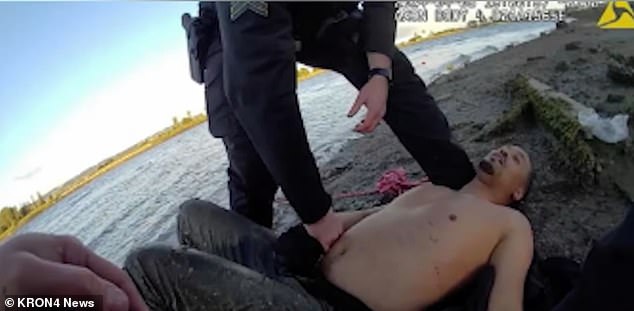Moment police tase unarmed father-of-two in water that left him in a coma as family launch lawsuit
Shocking body camera footage captured the moment an Oakland police officer tasered an unarmed father of two as he struggled in the water.
Deontae Faison, 35, was initially charged with driving with expired tags on his vehicle on April 5, 2024, leading up to the incident that left him in a coma and prompted his family to file a federal lawsuit.
East Bay Officer Jonathan Knea has been charged with violating district policy and Taser production guidelines after he was seen on bodycam footage deploying his stun gun and shooting Faison as he struggled in an estuary, police said. San Francisco standard.
The incident started when Faison and a white friend grabbed some food at a local Wendy’s, where Knea first noticed the truck’s tags had expired.
Deontae Faison, 35, father of two, has been unresponsive since East Bay Officer Jonathan Knea tased him on April 5, 2024
Faison and his friend then traveled to the park to have their meal, where Knea confronted them.
The officer was seen on body camera footage pointing a gun at Faison, who held his hands up, as Knea told him to get out of the vehicle and sit on the bumper.
Knea then asked him about the expired tags, but Faison told him he was not driving and gave the officer a false name.
He had felt like he was being treated differently than his white friend, who, according to the lawsuit, was not questioned about anything even though she owned the car and also gave a false identity. Reports on law and crime.
The lawsuit alleges that Faison began to become nervous about being “harassed in the park” for about 20 minutes when Knea questioned him and ran Faison’s alias through the Alameda County database, from which he found no results.
The officer then called for backup and threatened to ask a fingerprint technician to identify him, and Faison became “scared for his life,” according to the lawsuit.

Body camera footage of the incident showed Faison with his hands up in a truck as Officer Knea pulled out a gun and told him to get out of the vehicle.

Knea continued to deploy the Taser while Faison waded into knee-deep water, leaving the wire attached to Faison’s back.
He then started running towards the river mouth as Knea shouted at him to ‘get down’ and stop running.
The officer was then seen pointing the Taser at him.
The officer then fired the stun gun into Faison’s back from a distance, without “any announcement and without establishing any communication,” according to the complaint.
Faison subsequently collapsed, but managed to stagger into the river mouth.
By the time he was about knee deep, the suit says, Knea redeployed the Taser until the battery died, leaving the wire attached to Faison’s back.
According to the lawsuit, the victim then struggled in the water for more than 30 minutes, calling for help, before eventually falling face first into the estuary and beginning to take on water.
He then lost consciousness and floated to the other side, where officers pulled his body ashore.
But in the approximately 17 minutes before paramedics arrived, police did not perform CPR and did not tell paramedics that Faison had been tasered, the lawsuit said: according to the San Francisco Chronicle.

Faison lost consciousness and floated to the other side, where officers pulled his body ashore
An Alameda County sheriff’s deputy called to the scene later noticed Faison had been in the water for nearly 40 minutes.
He also noted that police tried to call Oakland police, firefighters and the Coast Guard for assistance, but “all water rescue equipment was unavailable at the time.”
The lawsuit also says Knea “failed to communicate to hospital staff” that Faison had been stunned multiple times “in an attempt to conceal the true nature of what happened to him and promote the false narrative that Deontae was simply drowned.’
Hospital staff only learned that he had been bagged the day after he was admitted, when medical personnel discovered the puncture wounds from the device.
‘When they saw him waving, trying to drown, begging for his life and for help, these people sat there casually on the beach looking as if [it] were a form of entertainment or amusement,” civil rights attorney Adanté Pointer said at a press conference on Tuesday: Mercury News reports.
“The officers’ deliberate indifference to Deontae’s life is appalling,” Pointer said. “They stood there for more than half an hour watching him struggle for his life.”

Faison now still requires a feeding tube and cannot move his eyes or limbs
The lawsuit, filed against Police Officer Jonathan Knea, the East Bay Regional Park District and Alameda County, now alleges that Knea violated department policy by using a Taser on a person who was in water — specifically salt water — because of the its conductivity.
Tasers can cause pain, loss of muscle control, increased heart rate and breathing difficulties.
But the East Bay Regional Park District only discourages — and does not strictly prohibit — officers from deploying a Taser “on individuals whose position or activity could result in additional injury,” including individuals “who are in the water,” according to KTVU.
It also accuses officers at the scene of lying in their report that Faison was armed at the time, and claims officers concealed evidence by turning off the body camera audio and by disposing of Taser components and Faison’s clothing.
The lawsuit further alleges that Knea knew his use of the Taser was endangering Faison, even verbally stating, “He’s not going to make it.”

His family said he could not attend his son’s high school graduation and 18th birthday
But police have previously claimed that Faison is a convicted felon who had a warrant out for his arrest.
Court records obtained by Mercury New show he was on probation after pleading no contest in a 2021 robbery case, but that probation appears to have been revoked in early 2023.
It is unclear whether it remained rescinded when Knea confronted Faison that day.
Still, Pointer told KTVU that Knea knew none of Faison’s history when he stopped him, saying the officer “escalated this situation.”
“It’s give in or die,” he said. “They used potentially lethal force during a minor traffic stop.”
Faison now still requires a feeding tube and cannot move his eyes or limbs, according to the Mercury News.
His oldest son, also named Deontae, turned 18 in June and graduated from high school, but his father wasn’t there to see it.
“His father never missed a graduation ceremony. His father has never missed a birthday. One of the biggest birthdays, one of the biggest celebrations, he wasn’t there and it’s not fair,” said the boy’s mother, Teyona Davis.
“I can’t even trust the people who are supposed to protect my son, because look what they did to his father.”
The younger Deontae added that his father’s coma “derailed our entire lives.”
‘I can’t go to the park. I can’t play basketball. It is very difficult for all of us,” he said.
